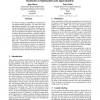Free Online Productivity Tools
i2Speak
i2Symbol
i2OCR
iTex2Img
iWeb2Print
iWeb2Shot
i2Type
iPdf2Split
iPdf2Merge
i2Bopomofo
i2Arabic
i2Style
i2Image
i2PDF
iLatex2Rtf
Sci2ools
IJCAI
2001
2001
Backbones in Optimization and Approximation
We study the impact of backbones in optimization and approximation problems. We show that some optimization problems like graph coloring resemble decision problems, with problem hardness positively correlated with backbone size. For other optimization problems like blocks world planning and traveling salesperson problems, problem hardness is weakly and negatively correlated with backbone size, while the cost of finding optimal and approximate solutions is positively correlated with backbone size. A third class of optimization problems like number partitioning have regions of both types of behavior. We find that to observe the impact of backbone size on problem hardness, it is necessary to eliminate some symmetries, perform trivial reductions and factor out the effective problem size.
Related Content
| Added | 31 Oct 2010 |
| Updated | 31 Oct 2010 |
| Type | Conference |
| Year | 2001 |
| Where | IJCAI |
| Authors | John K. Slaney, Toby Walsh |
Comments (0)

